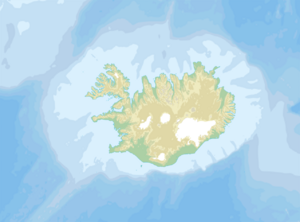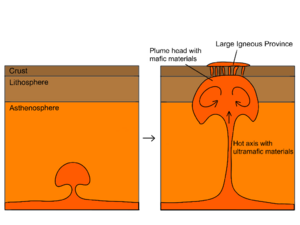Iceland Plateau facts for kids
The Iceland Plateau is a large, flat area under the North Atlantic Ocean. It includes the country of Iceland and the underwater land around it. Think of it like a huge, raised platform on the ocean floor. This area is always changing because new melted rock (called magma) keeps rising to the surface. Also, the Mid-Atlantic Ridge, which is a giant underwater mountain range where Earth's plates pull apart, is constantly shifting here.
Contents
What is the Iceland Plateau?
Where is the Iceland Plateau Located?
The Iceland Plateau is surrounded by several underwater ridges. To its south is the Reykjanes Ridge. To its west, you'll find the Greenland-Iceland Ridge. The Kolbeinsey Ridge is to the north, and the Iceland-Faeroe Ridge is to the east. This whole area is a "large igneous province". This means it's a huge region made from volcanic rock that has been active for millions of years, ever since the Miocene epoch. The plateau rises about 1,700 meters (about 5,577 feet) above the average sea level.
What is the Iceland Plateau Made Of?
The Iceland Plateau has three main layers, much like the oceanic crust found elsewhere.
- The first layer is mostly made of sedimentary rock. This rock forms from tiny bits of sand, mud, and shells that settle over time.
- The second layer is different from typical oceanic crust. It has many thick piles of lava flows. These are rocks that were once hot, melted rock that erupted and cooled.
- The third layer is a very thick section of gabbro. Gabbro is a type of igneous rock that forms when magma cools slowly deep underground.
How Did the Iceland Plateau Form?
The Iceland Plateau started to form around 56 million years ago. This happened when the North Atlantic Ocean began to open up. As the giant tectonic plates of the Earth slowly moved away from each other, melted rock (lava) rose from deep inside the Earth. This lava erupted and cooled, building up the underwater ridges and the plateau we see today.
Hotspots and Plate Movement
The Iceland Plateau is a great example of how a Mid-ocean ridge (where plates pull apart) and a hotspot can work together. A hotspot is like a super-hot plume of melted rock that rises from deep within the Earth's mantle. Imagine a giant, slow-moving lava lamp deep under the ocean!
This hotspot is located right under an active rift zone of the Mid-Atlantic Ridge. Over millions of years, this combination has caused huge amounts of volcanic rock, mostly tholeiitic basalts, to erupt. There are also several large rhyolitic domes that have formed. These are like big, rounded hills made of a different type of volcanic rock.
Today, the island of Iceland itself has two main parts. One part slopes down towards the ocean floor, while the other part is flatter and more level.



